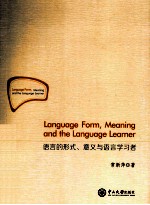

语言的形式、意义与语言学习者 英文PDF电子书下载
- 电子书积分:12 积分如何计算积分?
- 作 者:常新萍著
- 出 版 社:广州:中山大学出版社
- 出版年份:2014
- ISBN:9787306049278
- 页数:333 页
Chapter 1 Introduction 1
1.1 Issues and themes:two stances in linguistics and SLA studies 1
1.1.1 Form and Meaning in Second Language Learning 3
1.1.2 Two processes in SLA:Explicit learning and implicit learning 5
1.1.3 Learner factors 7
1.2 Definition of relevant terms 8
1.3 Motivations for this research 11
1.3.1 Practical needs 11
1.3.2 Theoretical needs 12
1.4 Research questions and delimitation 17
1.4.1 Methods used 17
1.4.2 Justification of the research 18
1.4.3 The delimitation of this research 18
1.4.4 Research questions 19
1.5 An outline of the book 19
Chapter 2 Pursuing an Understanding of the Underlying System 21
2.1 The competence-performance issue 21
2.1.1 The Competence-performance distinction 21
2.1.2 Hymes's introduction of communicative competence 25
2.1.3 Components of the Communicative Competence 29
2.2 Form,meaning or the mapping? 40
2.2.1 Rule-based approach 41
2.2.2 Usage-based approach 43
2.3 A critique of the previous theories 44
2.4 The present study and the previous review 50
2.5 Summary 53
Chapter 3 Pursuing an Understanding of Second Language Learning Processes 55
3.1 Theories of naturalistic second language learning 55
3.1.1 The distinction between naturalistic learning and classroom learning 55
3.1.2 Studies on the internal processing mechanism 57
3.1.3 Research on L2 acquisition 61
3.1.4 Factors involved in SLL process and relationships among them 75
3.2 Theories of classroom second language learning 76
3.2.1 Theories about classroom learning 76
3.2.2 Factors involved in classroom L2 learning 78
3.3 Factors influencing SL/FL learning processes 79
3.3.1 Summary of factors from the review 79
3.3.2 Factors singled out for the present study 79
3.3.3 A brief review of the factors for this study 80
3.4 SLA theories and the present study 86
3.5 Summary 87
Chapter 4 A Working Conceptual Framework for the Research 88
4.1 Introduction 88
4.1.1 The necessity to establish a working conceptual framework 88
4.1.2 Characteristics of Chinese secondary school EFL learning 89
4.2 The working conceptual framework 90
4.3 Questions and hypotheses in the experiment 99
4.3.1 Research questions in relation to the experiment 100
4.3.2 Hypotheses in the experiment 101
4.4 Questions and hypotheses in the investigation 102
4.4.1 Research questions in relation to the investigation 102
4.4.2 Hypotheses about the relationships between the experimental results and the factors under investigation 103
4.5 Summary 104
Chapter 5 Design of the Research 105
5.1 Initial thinking 105
5.1.1 Research methods 105
5.1.2 Background knowledge of the participants under study 106
5.2 Design of the experiment 108
5.2.1 The sample for the experiment 108
5.2.2 Instruments for the experiment 110
5.3 Design of the investigation 117
5.3.1 The sample for the investigation 118
5.3.2 The instrument for the investigation 118
5.3.3 The content of the questionnaires 118
5.4 Data Collecting Procedure 120
5.4.1 The implementation of the experiment and the investigation 120
4.4.2 The rating of the tasks 121
5.4.3 Data Coding 122
5.5 Summary 123
Chapter 6 Presentation of Results 124
6.1 Data sorting 124
6.1.1 Collating data from the experiment 124
6.1.2 Collating data from the investigation 129
6.1.3 Analyses of the data from the experiment and the investigation 130
6.2 Presentation of the results from the experiment 130
6.3 Presentation of the results from the survey 152
6.3.1 Presentation of the results concerning the questions 152
6.3.2 Presentation of the results concerning the hypotheses in the investigation 166
6.4 Summary 177
Chapter 7 Discussion of the Results from the Experiment and the Investigation 179
7.1 Discussion of the results from the experiment 179
7.1.1 Summary of the results from the experiment 179
7.1.2 Discussion of the results from the experiment 180
7.2 Discussion of the findings from the survey 201
7.2.1 Findings from the QL and their relationships with the experimental results 202
7.2.2 Case analysis 218
7.2.3 Analysis of the questionnaire for the teachers(QT) 222
7.2.4 Summary of the discussion in relation to the conceptual framework 225
7.3 Summary 227
Chapter 8 Conclusion 228
8.1 Overview 228
8.2 Summary of the findings in this research 229
8.2.1 The nature of the EFL 1earners'attainment 229
8.2.2 The learners'attainment and factors underpinning their learning process 230
8.3 Significance of the research and the discussions 233
8.4 Implications of this study 234
8.5 Limitations and Future Studies 241
8.6 Remarks on language form,meaning and the language learner 242
References 244
Appendix 1 264
Appendix 2 288
Appendix 3 306
Appendix 4 314
Appendix 5 330
- 《党员干部理论学习培训教材 理论热点问题党员干部学习辅导》(中国)胡磊 2018
- 《程序逻辑及C语言编程》卢卫中,杨丽芳主编 2019
- 《幼儿园课程资源丛书 幼儿园语言教育资源》周兢编 2015
- 《深度学习与飞桨PaddlePaddle Fluid实战》于祥 2019
- 《全国普通高等中医药院校药学类专业“十三五”规划教材 第二轮规划教材 有机化学学习指导 第2版》赵骏 2018
- 《思维的囚徒 活出生命的意义7原则》赵晓瑞译;(美)亚历克斯·佩塔克斯 2019
- 《高等学校“十三五”规划教材 C语言程序设计》翟玉峰责任编辑;(中国)李聪,曾志华,江伟 2019
- 《音乐语言的根基》张艺编著 2019
- 《认知语言学视野的抽象方位结构研究》曹爽著 2019
- 《激活语言思维》李蒨,王宏年,汤青编著 2017
- 《中学历史教师素养研究》李漱萍著 2019
- 《图像与神话》刘惠萍著 2019
- 《社会保障预算、精算与核算》王晓军,李静萍著 2019
- 《城市垃圾治理中的公众参与研究》张莉萍著 2019
- 《图书馆管理策略与阅读服务创新研究》袁萍著 2020
- 《近五百年黄土高原的环境扰动与社会变迁》张萍著 2019
- 《英语阅读教学与写作研究》汪艳萍著 2017
- 《怪物考 中世纪幻想艺术图文志 典藏版》王慧萍著 2018
- 《林徽因传 时光深处的倩影》杨祯萍著 2018
- 《西北非中心城市高校青年教师教学发展研究》邱艳萍著 2018
